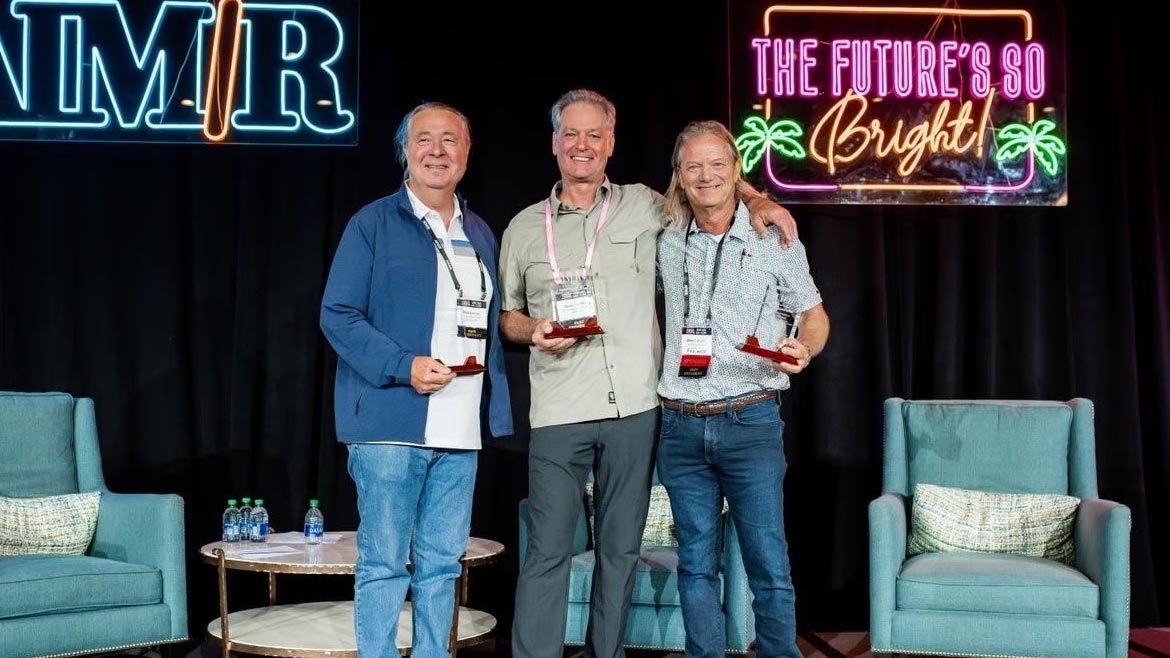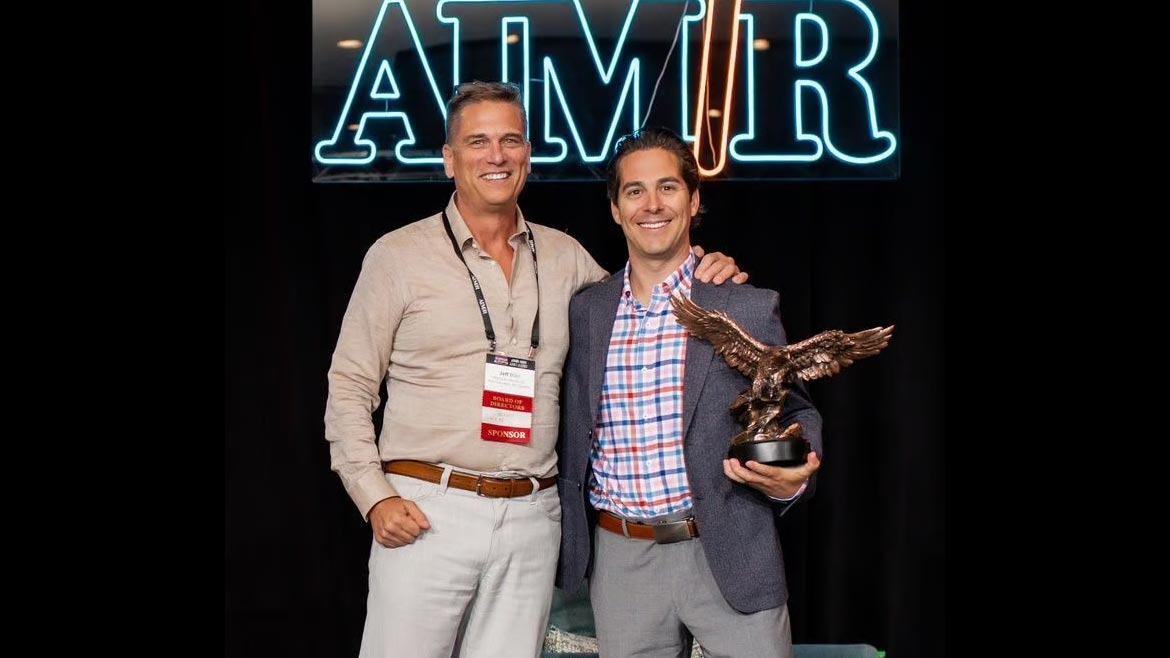The 51st annual Association of Independent Manufacturers’ Representatives (AIM/R) conference drew a record-setting crowd to Miramar Beach, Florida at the Sandestin Golf and Beach Resort. More than 500 attendees gathered for roundtables, educational sessions and endless networking opportunities.
Some highlights from the event include the annual Golden Eagle Award and the induction of new members of the AIM/R Hall of Fame. Oatey’s Co.’s VP, Wholesale, Patrick Aquino, took home this year’s prestigious Golden Eagle award while Keyline Sales’ Rick Banner, Rich-Tomkins’ Stew Chafee, and Pepco Sales and Marketing’s Mike Parham were inducted into the AIM/R Hall of Fame. AIM/R also introduced a new session series called "AIM/R Live" where members and suppliers gather for a casual, off the cuff conversations about the industry’s most critical concerns.
The association is geared up for another successful, growing year helping manufacturers’ reps tackle everyday challenges, grow their market-share and prepare for the future of the PHCP-PVF industry. Each year during the event, AIM/R nominates a handful of rep members to sit with Supply House Times for an exclusive roundtable discussion. This year’s conversation highlights included: The challenge of engaging with engineers, how consolidation affects reps, the ever-growing need for digital marketing, tips for hiring in a tight labor market, industry diversity and the growing value of AIM/R membership. This year’s participants were:
- Ashley Messier, CPMR, president, Osborne Company;
- Katie Brummund, CPMR, plumbing division manager, Midwest Sales & Marketing;
- Scott Cooper, CPMR, president, Cooper New England Sales;
- Joel Golmont, CPMR, president/principal, Smith & Stevenson Co.
- Benn Freeman, CPMR, president, Spirit Group; and
- Bo Beard, CPMR, president/principal, smith & Stevenson Co.
The conversation kicked off with a big picture question — how would you describe the role of manufacturers’ rep in 2023 and 2024? Brummund said the role is changing quickly in order to keep up with a fast-paced marketplace.
"The market is changing fast; our manufacturers are merging which means we’re having to adapt to changes that we have no control over," she said.
Freeman brought up the element of competition that is always in play for reps. “The bar is always being raised,” he said. “As agencies improve nationwide, we understand that expectations rise. We must pay attention to reps that are not necessarily our local competitors to see what they’re doing to improve their business. It’s all about continuous improvement. What will never change is that we view ourselves as an extension of our manufacturers and we view the companies we work with as partners.”
Beard agreed, saying the basics haven’t changed, but the details have. "What our business is about and the focus on relationships hasn’t changed, but we’ve had to become more specialized in those relationships," he explained. "We are calling on builders, general contractors and other networks that are outside the traditional calling on the contractor that we’re used to."
In order to call on these different segments, reps are having to expand their teams in ways you wouldn’t see previously. They’re adding business development teams, engineering teams, residential teams and so on. "We’re expected to find specialists for these different segments and build teams upon them," Messier said. "We’re extremely channel-focused today, and one of our greatest challenges is finding the right candidates to fill those specialized roles that our manufactures now expect to see."
Messier added that reps must be strategic with which segments they grow, because if it’s not the same strategy a manufacturer sees fit, there can be a disconnect.
Cooper said reps have transformed from the source of information to more technical presenters. "In years past we were the source for information. Often times if the rep didn't go show someone a new product or announce a price increase, nobody would know about it," he explained. "We have evolved to become more technical and better presenters and explainers. People can get information from the internet, but it is up to us to make sure our partners in the market truly understand what our products do and how to apply them."
These reps agree that manufacturers expect more details about the specialists they have on their sales teams and are demanding data to back up their decisions. "There’s so much data now that we have to prepare prior to calling on each different group," Brummund said.
Freeman shared his reliance on data for decision making. “Using facts and information helps take the emotion out of the conversations,” he said. “We’re able to approach conversations with numbers to explain our expectations and decisions, so utilizing more data helps with those tougher conversations.”
Messier explained that post-COVID, the role of the rep is a constant balancing act, and it’s a unique time full of intentional conversations with manufacturer partners.
"During COVID when we weren’t traveling for traditional sales, we truly became a steward of our factories; a true extension of them rather than just a partner," he said. "They relied on us for data and insight, so much so that we made heavy investments in technology. Now that we’re back on the road, some factories are taking that onus back inside without truly understanding the value we brought them when they really needed it."

Mike Parham, CPMR of Pepco Sales and Marketing, Stewart Chaffee, Jr. of Rich Tomkins Company, and Rick Banner, CPMR of Keyline Sales Inc. were inducted into the Aim/R Hall of Fame.
CONNECTING WITH ENGINEERS
Manufacturers’ reps are no strangers to curve balls and constant challenges. One new challenge brought up during this year’s roundtable was unanimous around the table — engaging with the engineering community is tough post-COVID.
While the contractor and wholesaler either never left the jobsite or came back shortly after the initial COVID-19 shutdown, many within the engineering community never returned to an in-office setting. Freeman explained that since engineers work on billables, the best time to call on engineers was before or after their workday, or during a lunch-and-learn.
"Some firms still aren’t 100% back in the office, so it’s been harder to connect with them and influence that specification,” Freeman said.
Brummund adds that she’s tried virtual lunch-and-learns, but the human connection is lost and you miss out on the side and after conversations which are generally the best part.
"The engineering office is not what it used to be," Messier summarized. "Some firms bring everyone into the office once a week, and those are often days no one else is allowed in the building. With about 95% of our engineers working remotely, we’ve had to invest time and resources into ASPE and ASHRAE and be very vocal in our support to those networks in order to connect with the engineering Principals."
Golmont added that COVID made engineers, like other business verticals, take a hard look at how they were spending their time. "Many of them realized they don’t need to be seeing as many salespeople as they were seeing pre-COVID," he said. "The Principals are eager to have us train their newcomers, and we are happy to train them, but at the end of the day we need access to the decision makers."
Connecting with engineers and all other channels as the marketplace evolves will be a continuous challenge for reps. According to Freeman, being efficient and prepared is key.
"Engineers’ time is extremely valuable. Being prepared and efficient is our approach to working with them. Taking time away from a project they are working on costs them time and money, so we make that time with them count."
Cooper agrees, adding that creativity is key. "We have had to rely on our creativity in some cases to get these meetings in various off site locations, but it is our responsibility to maintain contact with this vital segment of our industry."

AIM/R Senior Vice President of Industry & PR presents the AIM/R Golden Eagle Award to Patrick Aquino at the 51st Annual Conference
CONSOLIDATION CHALLENGES
Consolidation is happening all around us in the PHCP-PVF industry. These reps agree manufacturer consolidation is making it increasingly difficult to manage competition between lines.
"The line conflict is starting to become enormous," Beard said. "It’s to the point where manufacturers are going to have to embrace the conflict to a certain extent."
Freeman agreed, adding that Spirit Group has seen many product overlaps as a result of industry consolidations, and good communication allows it to work. “If we grow the business for each company, results are really what we are all looking for.”
Cooper agreed, saying, "These situations can be managed if both parties are upfront and honest about how to co-exist on an agency's line card."
When it comes to consolidation at the distributor level, Messier says it can be a positive or negative for reps. "If a distributor partner of yours is acquired by a larger distributor, usually the larger, acquiring company’s lines take precedence."
Messier continued by explaining that "smaller distributors are the lifeblood of the rep business," when it comes to ancillary product because they don’t have the buying power of the owned brand.
"Consolidation is going to continue," he added. "You’re going to see a lot of factories go direct because reps can’t move the needle to keep up with consolidation, or you’ll see a lot of factories acquired themselves."
Brummund brought up another side effect of distributor acquisitions that is changing the game for reps. "As wholesalers acquire each other and take over larger territories, it’s becoming harder for reps to know and manage those relationships with key players," she said. "It used to be very localized and reps would stay in their own local markets, but now we’ll be calling on other reps in neighboring areas to get information about key players in this new, larger district that we didn’t deal with before."
Cooper summarized how to deal with consolidation by explaining that strong relationships will pull reps through. "With consolidation on the wholesaler side, you could instantly gain or lose a major partner in the market," he said. "Both of these situations underscore the importance of having strong relationships with the contractors and specifiers in your territory. It's the best insurance policy a rep can have."
TAKING ON THE MARKETING ROLE
Not only are reps having to expand their personnel in terms of channel expertise, they are having to take on more of a marketing role than ever before. These reps agree that social media continues to grow more important to a reps credibility and reputation with manufacturer partners.
"We can look to the social media accounts of our manufacturers and use those as a barometer of what they will expect and need from us," Freeman said. "We don’t have a full-time social media or marketing person yet, but we’re getting there."
Brummund says Midwest Sales and Marketing is in a similar boat. "We don’t yet have a full time person for this either, but it’s something we have analyzed," she explained. "We have to figure out if it’s a full-time role or not, what is the ROI; it’s hard to put dollars to that position."
The reps agreed it’s also difficult to identify a reps target audience when it comes to social media — is it your contractor and engineer customers or is it manufacturers and potential manufacturer partners?
"While we want to reach all customer segments, creating demand for our manufacturer’s is what is most important for us; they’re looking at what we’re doing online and comparing it to other rep firms,” Freeman explained. “Again, the bar is being raised, and we as reps have to meet the new expectations that are being set around us, which helps us improve."
Messier came to the table having some experience testing and analyzing social media performance, and he said it’s all about showing the manufacturer data that proves what type of content works online.
"You can show the manufacturer what they want to see on social, but you can also prove to them that they’re not your true audience," he said. "Our company is very tech-based and data driven, so we’ve actually tested engagement levels on various social channels. We found that there is virtually no engagement with many of the self-promotional posts our manufacturers were posting."
Messier continued to explain that content that does perform well on social media is educational. "We’re now trying to show our factories that social media presence needs to be another vehicle of communication, not a marketing tool," he added. "We’ve reached 6,000 LinkedIn followers as a rep, which took a lot of time and investment. The next step will be getting manufacturers to back us financially to fuel this growth, which will benefit us and them in the long run."
EXPANDING THE HIRING POOL
No 2023 business roundtable discussion would be complete without talk of hiring strategies and personnel concerns. Freeman immediately brought an interesting idea to the table — looking to the service industry for good candidates.
"We’ve found success in finding those personable people in the service industry, particularly restaurants, that clearly have multitasking abilities and customer service skills. We can teach them what they need to know about our business, it’s the unteachable skills that are hard to find,” he said. “When someone makes an impact on you, it’s worth starting the conversation to see if they’re interested in a new role. Worst case is they say no, and you’ve made their day with a compliment.”
Some reps around the table have had similar success, finding candidates in Lowes for example, while others point out they’ve been burned by this strategy. Either way, it’s a good idea to be open minded in a tight labor market like the one we have today.
Brummund shared that her most successful hiring has been through referrals, which speaks to the importance of culture.
Freeman agreed, saying at Spirit Group they involve team members in the interview and hiring process. "In most cases our employees are going to be working closer with this person than the final decision maker, so it helps maintain our culture by having multiple levels involved in the hiring process."
The roundtable participants agreed that while diversity is evolving in our industry, it isn’t happening fast enough.
Freeman pointed out that ASA’s women in Industry Division is a great example of the growing diversity as the division and its annual event, ELEVATE, grow in size each year. The group also noted that women in leadership is becoming more evident as you can see at AIM/R and on the current AIM/R Board of Directors.
Messier points out that while PHCP-PVF companies want the diversity to come fast, the talent pool of diverse candidates is not readily available. "We want this to move faster, but we’re competing with large tech companies and more desirable industries," he said. "Our customers are changing and evolving, so we want to be as well, but the diversity in who shows up to the interviews isn’t changing yet."
Cooper pointed out that he believes a lot of the work ASA has been doing to draw in new candidates has begun paying off, and he thinks the next generation of candidates presents a good opportunity for our industry.
"We’re fighting the fact that the PHCP-PVF industry is categorized as ‘not sexy,’ along with the fact that most people don’t even understand what a manufacturers’ rep does," he says. "I think the generation coming up now is a lot more practical than the one prior, and they are more willing to take a look at our industry and understand its importance."
ONGOING VALUE OF AIM/R
At the end of a long conversation tackling numerous hot-button topics for reps, the participants agreed that the value of the relationships and networking that comes from AIM/R can’t be beat.
"Where else can we talk directly to agencies that are going through the same dilemmas as we are?" Beard said. "Just being able to talk things like this through and take good ideas home is well worth the investment in AIM/R."
Messier agreed, adding that AIM/R gives reps the chance to learn from peers that you wouldn’t necessarily have met otherwise. "AIM/R provides that outside community of peers that have no interest in my business other than helping a friend succeed."
"I don’t know how many times I’ve called friends from AIM/R to talk through a challenge or gain perspective," Freeman added. "Coming to AIM/R year after year keeps those relationships alive."
Cooper adds that while the primary benefit of AIM/R is and has always been networking, the association has evolved in a lot of ways. "What AIM/R does year-round to provide monthly educational webinars shouldn’t go unnoticed," he said. "The organization has evolved tremendously from being primarily focused on getting people together once a year to being focused on being a continuous resource for reps to grow and prove their value in the industry."





